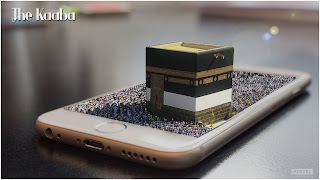Photo Manipulation
The history and form of the Kaaba
The Kaaba was a sanctuary in pre-Islamic times. Muslims believe that Abraham—known as Ibrahim in the Islamic tradition—and his son, Ismail, constructed the Kaaba. Tradition holds that it was originally a simple unroofed rectangular structure. The Quraysh tribe, who ruled Mecca, rebuilt the pre-Islamic Kaaba in c. 608 CE with alternating courses of masonry and wood. A door was raised above ground level to protect the shrine from intruders and flood waters.
Muhammad was driven out of Mecca in 620 CE to Yathrib, which is now known as Medina. Upon his return to Mecca in 629/30 CE, the shrine became the focal point for Muslim worship and pilgrimage. The pre-Islamic Kaaba housed the Black Stone and statues of pagan gods. Muhammad reportedly cleansed the Kaaba of idols upon his victorious return to Mecca, returning the shrine to the monotheism of Ibrahim. The Black Stone is believed to have been given to Ibrahim by the angel Gabriel and is revered by Muslims. Muhammad made a final pilgrimage in 632 CE, the year of his death, and thereby established the rites of pilgrimage.
Modifications
The Kaaba has been modified extensively throughout its history. The area around the Kaaba was expanded in order to accommodate the growing number of pilgrims by the second caliph, ‘Umar, who ruled 634-44 CE. The Caliph ‘Uthman, who ruled 644-56 CE, built the colonnades around the open plaza where the Kaaba stands and incorporated other important monuments into the sanctuary.
During the civil war between the caliph Abd al-Malik and Ibn Zubayr, who controlled Mecca, the Kaaba was set on fire in 683 CE. Reportedly, the Black Stone broke into three pieces and Ibn Zubayr reassembled it with silver. He rebuilt the Kaaba in wood and stone, following Ibrahim’s original dimensions, and also paved the space around the Kaaba. After regaining control of Mecca, Abd al-Malik restored the part of the building that Muhammad is thought to have designed. None of these renovations can be confirmed through the study of the building or archaeological evidence; these changes are only outlined in later literary sources.
Reportedly under the Umayyad caliph al-Walid, who ruled 705-15 CE, the mosque that encloses the Kaaba was decorated with mosaics like those of the Dome of the Rock and the Great Mosque of Damascus. By the seventh century, the Kaaba was covered with kiswa, a black cloth that is replaced annually during the hajj.
Under the early Abbasid Caliphs, who ruled from 750-1250 CE, the mosque around the Kaaba was expanded and modified several times. According to travel writers, such as the Ibn Jubayr who saw the Kaaba in 1183 CE, it retained the eighth-century Abbasid form for several centuries. From 1269-1517 CE, the Mamluks of Egypt controlled the Hijaz, the highlands in western Arabia where Mecca is located. Sultan Qaitbay, who ruled 1468-96 CE, built a madrasa—a religious school—against one side of the mosque. Under the Ottoman sultans, Süleyman I, who ruled 1520-1566 CE, and Selim II, who ruled 1566-74 CE, the complex was heavily renovated. In 1631 CE, the Kaaba and the surrounding mosque were entirely rebuilt after floods had demolished them in the previous year. This mosque, which is what exists today, is composed of a large open space with colonnades on four sides and with seven minarets, the largest number of any mosque in the world. At the center of this large plaza sits the Kaaba, as well as many other holy buildings and monuments.
The last major modifications were carried out in the 1950s by the government of Saudi Arabia to accommodate the increasingly large number of pilgrims who come on the hajj. Today the mosque covers almost 40 acres.








No comments:
Post a Comment